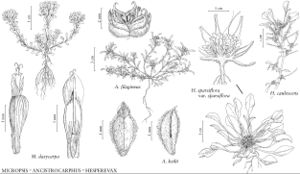Ancistrocarphus
Proc. Amer. Acad. Arts 7: 355. 1868.
| Taxon | Illustrator ⠉ | |
|---|---|---|
 | Micropsis dasycarpa Ancistrocarphus filagineus Ancistrocarphus keilii Hesperevax sparsiflora var. sparsiflora Hesperevax caulescens | Linny Heagy Linny Heagy Linny Heagy |
Annuals, 0.5–14 cm. Stems 0 (A. keilii) or, usually, 2–10 and ascending to prostrate, sometimes 1 and ± erect. Leaves basal or basal and cauline; alternate; blades oblanceolate to obovate. Heads borne singly or in glomerules of 2–5 in ± cymiform arrays. Involucres 0 or inconspicuous. Phyllaries 0, vestigial, or 3–6, ± equal (unlike paleae, hyaline). Receptacles distally expanded,± fungiform or hourglass-shaped (heights 1–2 times diams.), glabrous. Pistillate paleae tardily falling or ± persistent, erect to ascending; bodies with 3 nerves (nerves ± parallel, prominent, or midnerves sometimes thinning with age, obscure), ± boatshaped to ovoid, saccate most of lengths (obcompressed, not galeate, each enclosing a floret); wings erect or incurved (apical). Staminate paleae persistent, 5 (–7), ± spreading proximally (and enlarged) in fruit, shorter than or surpassing pistillate paleae; bodies lanceolate or spatulate (apices incurved to uncinate). Pistillate florets 5–11. Functionally staminate florets 3–6; corolla (zygomorphic, ± gibbous in A. keilii) lobes 4–5 (–6), equal or unequal. Bisexual florets 0. Cypselae uniformly brown or proximally black-banded, monomorphic: obcompressed, obovoid, slightly incurved, not gibbous, faces glabrous, smooth, dull; corolla scars apical; pappi 0.
Distribution
sw United States, nw Mexico
Discussion
Species 2 (2 in the flora).
See discussion of Filagininae following the tribal description (p. 385).
Ancistrocarphus is found in temperate Mediterranean to semiarid climates. It consistently resolved as the sister of Hesperevax in phylogenies based on morphology (J. D. Morefield 1992). Ancistrocarphus is not closely related to Stylocline, where it has been placed based on sharing saccate, winged pistillate paleae. The pistillate paleae of Ancistrocarphus differ from those of Stylocline and all other Filagininae in having two prominent lateral nerves in addition to the (sometimes obscure) medial one.
Addition of Ancistrocarphus keilii made the genus more heterogeneous and somewhat bridged the gap with Hesperevax. That species may be derived from a common ancestor of, or a hybrid between, the two genera. It shares most of its character states with A. filagineus; the two species consistently resolved as sister taxa in all phylogenetic analyses (J. D. Morefield 1992).
Selected References
Lower Taxa
Key
| 1 | Stems (1–)2–10; leaves basal and cauline; staminate paleae 2.7–4.1 mm, surpassing pistillate, broadly lanceolate, apices uncinate, acuminate, spinose; cypselae 1.4–2 × 0.6–0.9 mm, transverse bands 1; pistillate paleae: wings prominent, ovate | Ancistrocarphus filagineus |
| 1 | Stems 0; leaves basal; staminate paleae 1.8–2.8 mm, slightly surpassed by pistillate, broadly spatulate, apices incurved, obtuse to rounded, apiculate, not spinose; cypselae 1–1.4 × 0.5– 0.6 mm, transverse bands 0; pistillate paleae: wings obscure, lanceolate | Ancistrocarphus keilii |